The Lockdown Projects - Page
6
We may have expected these Lockdown Project
Pages to be short-lived and merely a way of seeing what our fellow Club Members
were working on in these difficult (Covid-19) times.
Page 1 of the Lockdown Projects was published in May 2020 - and here we
are in July 2021 with Page 6. 😊
On this page there will be displays of work created by Members whilst on lockdown. These are the 'Lockdown Projects'. This is the equivalent of the 'display table' from Club nights. This is Page
6 of the projects - click HERE to display Page 1,
HERE
to display Page 2, HERE
to display Page 3, HERE to display Page 4
and HERE to display Page 5
|
Arthur Kingdon has been hard at work in
his workshop working on several projects. |
 |

|
 |
| Arthur has also been working
on his regular woodturning lathe to make a couple of goblets. On the right is a natural edge goblet made in spalted/ rotten elm (from a neighbour's garden) for the bowl and the base, with a blackwood stem - approx. 7" tall. Below is a natural edge, lidded goblet in yew and boxwood - approx. 10 1/2" tall. The hole in the side of the bowl is a natural 'feature' in the timber (not a careless mistake!). |
 |
 |
 |
Dave Branscombe has sent in a number of his projects. He says "The natural edge ash bowl ( 5 1/2" diameter by 3" tall at its highest point, with a 0.4" wall thickness) is one of the last remnants of the "Club Ash Tree" from many years ago and it's the first one where I have managed to fully retain the bark. There are a few technical flaws that you'll only notice close up and I'm pleased with the form, even wall thickness and standard Carnuba wax finish (Beall buffing system). There is a natural split that runs through the bowl and obviously there are myriad ways to deal with it. I went for a simple contrasting light ash wax filler so that you can still feel that there's a natural fissure but it also looks okay. This one's a keeper for the display shelf (until I make a better one)" Also shown is the tooling used to make the part and a bowl former/ support used to reverse turn the bowl to finish the base. The final 'nib' was hand-sanded flat. |
|
 |
 |
 |
 |
This small bowl is made in Iroko - 4" diameter by 1 1/2" tall with a 5 mm (0.2") wall thickness. Dave says "I like the natural colour fade from outer dark to the lighter inner - finished in Carnuba wax and buffed. Purpose: healthy eating snack bowl 'cos you can't get much in it!" |
|
 |
 |
This is a lazy susan cheeseboard that I was asked to make for a friend for Christmas. The brief was that it had to be "rustic and chunky" so I went for two 12" diameter by 1" thick platters in ash - finished with 3 coats of Chestnut food safe finishing oil. The recipient was very pleased with the result! |
 |
 |
 |
Dave was approached by a work colleague who asked if a stand could be made for his water carafe, and also to utilise some old tiles that had been liberated from an old swimming pool. The stand which measures 6" diameter by 2" tall is made of ash. The original attempt was glued with Gorilla polyeurathane glue (no idea why I thought that was a good idea at the time) which expanded and shifted the tiles. I had no choice but to take the whole piece to the bandsaw in order to preserve the tiles. The second attempt was done properly so that I recessed the tiles and just glued them with a thinner application of Gorilla glue! (the "no nails" equivalent). |
|
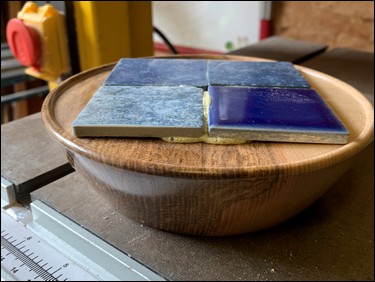 |
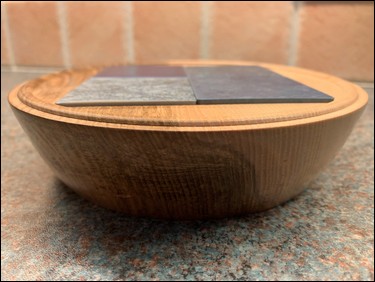 |
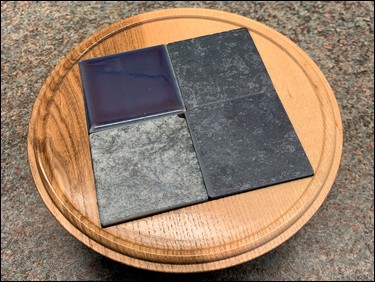 |
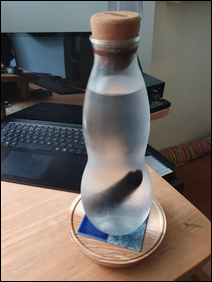 |
| I
was also asked to make 4 fence post tops for a friend who is also a
local bellringer (very close, but, not quite identical!). The fence post caps are literally old pine fence posts. The bases came from a 5" x 3" post (just cut to shape on the bandsaw) and the bells from an old 3" square post. |
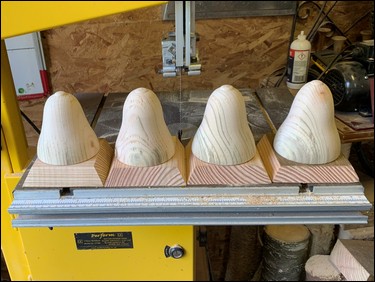 |
|
Sam Pearce has contributed the following. After watching a YouTube video by Huw via (wooden-it-be-nice). See: https://www.youtube.com/watch?v=Cf28gk8MRTk Sam was inspired to make pens with a celtic knot decoration - this involves much accurate cutting and glueing of coloured plastic veneers! The pen blank at the top is in Tanga Tanga (species-Albizia Versicolor from Africa) and the lower one is Yew. When the pen is turned - the cross/ knot appears. |
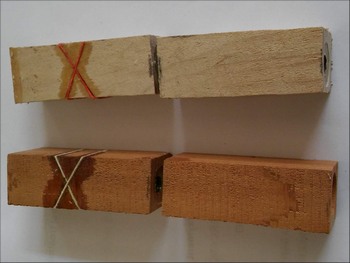
|
 |
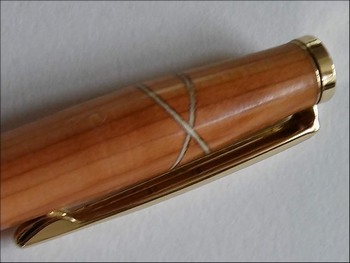
|
|
Ian Full has
been making some 'garden size' hedgehogs - approx 4" diameter by 5
1/2" long. the timber used was oak - the body was scortched
with a blow-torch, then re-turned - finished with multiple coats of
Danish oil. |
|
 |
|
This garden mushroom is made in silver birch from my daughter's garden in Exeter. It has now been relocated back to her garden. I believe it is not a very suitable timber for outdoor use and may not last long - a finish has not been applied. The size is approx. 20" tall by 6" diameter. Not the best shape for a mushroom, but it was restricted by the timber size available. |
 |
Ken Gateley has made a tall necklace stand (to his wife's specification) in yew. The stand is approx. 11" tall and features 8 pegs in the top - 4 long ones and 4 short. |
 |
 |
 |
 |
 |
 |
 |
When he is not turning, Ken pursues the other side of his hobby - making 'flat stuff'! Here he has made three stylish serving boards; ideal for cheese, crackers, pots of condiments/ pickles etc. Made in oak, with three different handle styles, complete with a hanging hole. The boards measure approx. 18" long by 5" wide by 5/8" thick - finished with several coats of rapeseed oil. |
|
 |
 |
Ken found an attractive piece of timber in his workshop - species unknown - it might be walnut (maybe iroko), but is possibly too oily? He has made a couple of tea light holders in the mystery 'tree-wood' - a 3-light holder in a heart shape and a variation on his Yin Yang holder. This one is approx. 5" diameter by 1 1/8" thick. Both items were finished with microcrystalline wax. See Ken's personal gallery for a further example of his Yin Yang tea light holder. |
 |
 |
 |
|
Ken has constructed a very
interesting item that combines woodturning with his 'flatwork'. This 'Trilobe Stool' has a sycamore top with 3 ash legs - finished with microcrystalline wax. The seat is 13 3/4" across the lobes and stands 13 1/2" tall. |
 |
|
Vernon Hughes
has sent in several examples of his 'Polka Dot' pots. He says
"that as a design feature the first item he made using circular
inlays/ inserts for decoration was a three-legged stool, made in
1999. The idea came whilst trying to find an original
decorative idea. The dots may not be original but I had not
seen them used up to the time the idea came". Vernon adds that
"I like to think that I had the idea before Emma Bridgewater adopted
it in pottery". Regarding the purpose of these pots Vernon states: "I only make useful/ useable items in the absence of artistic design talent. The taller pot can serve as a pen/ pencil etc. holder and as a dice shaker. The shorter pot makes an excellent 5 - poker dice shaker despite its seemingly small dimensions. The main dice game played is Yacqui (there are other spellings). I will explain/ demonstrate for anyone interested who does not know the game. It is excellent for familiarising youngsters with mental arithmetic and decision-making, as well as being competitive fun for all ages. A special-to-purpose scoresheet is required. When ordering dice online, the key is to type 'poker dice'; they can be remarkably cheap at £2-£3 per set of five high quality pieces". Practicalities of using inserts - All timber must be perfectly dry to prevent subsequent movement. Careful measurement is crucial to get the peripheral spacings precise (a needleworker's soft tape measure is ideal for the purpose). The inserts are turned individually on the lathe, a 1" straight scraper being used to achieve perfect cylinders. The dots are made to expose side-grain only; end-grain might make an interesting alternative but I have not experimented with it. Care must be taken throughout the dot-making process to ensure that the side-grain is at 'the end' of each cylinder; it is easy to lose track when working at this fairly miniature level. A nice finishing touch is to align the insert grain direction with that in the body. I cannot claim to have always achieved this... |
|
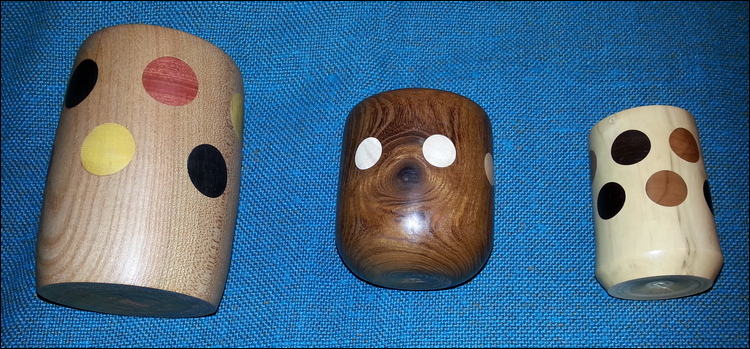 |
|
Shown above far left - Taller Pot details - Timbers - Ash body with Ebony, Bubinga and Mahonia Japonica inserts. Dimensions - Height 4" by 2 ¾" external diameter at widest point. The internal diameter is 2 ¼" by internal depth of 3 ½" Finish applied is sealer and soft waxed - followed by carnauba. Shorter Pot details: Timber - Laburnum (probably) with Sycamore inserts. Dimensions - Height 2 ¾" by external diameter 2 ½" at widest point, by internal diameter of 2" by internal depth of 2 ¼" Finish applied is sealer and soft waxed - followed by carnauba. |
|
 |
|
| Three further
examples of Polka Dot pots. The pot - third from the left is in burr
elm with a brass powder + 2-part epoxy resin infill. ********************************************************************* |
|
Vernon has submitted the following "Lockdown Tale" to add some insight into the story behind the acquisition of the timber for the elegant vase made by Bob Wells - shown below, next section. A LOCKDOWN TALE Club Members may, or may not recall that just before the start of Lockdown in early 2020 we were offered a whole Yew tree for free from a garden in Bath. The tree was having to be felled for legitimate reasons. In the event three members expressed an interest in collecting a share and I chipped in as well, more to help with transportation than out of need for the timber as I already had a good stock. Planning a collection programme was just getting under way when Covid-19 struck and even the tree surgeon had to stop work after having de-branched the tree but leaving the bare trunk still in the ground. He had trimmed the branch-wood and cut it into suitable lengths for transportation by car and trailer, but collection was rendered impossible by Covid restrictions. Over time our benefactor, Mr. David Adams, took it upon himself to move the timber from the back to the front of his house and covered it using a couple of well-worn tarpaulins, to give some protection from the effects of British summer sun. Fortunately, the tree surgeon got back to work at the earliest safe opportunity and during the autumn 2020 lull, reduced the trunk to just about manageable sections. Eventually, in separate visits the four of us, Bob Wells, Steve Lloyd, Mike Crawshaw and I, did manage to collect the timber, Mike using his trailer to great effect assisted by Steve. So that was that and the timber haul was safe in the hands of the new owners for seasoning (a particularly uncertain process with Yew), whilst keeping in mind that we had undertaken to make a few items for David Adams in recognition of his generosity. That was something to keep in mind until 'whenever' I had been thinking. But not so Bob Wells! To my utter surprise and admiration, a few days ago he came up with an outstandingly beautiful vase. I am not entirely satisfied with the photos, because they seem to have not captured the proportions faithfully(?), but they do show the sheer beauty of the timber as exposed by Bob's fine work. The piece stands 15.5 inches tall - in its splendid slim form and is a joy to behold. Immense thanks and appreciation Bob! I will arrange handover to David as soon as mutually convenient but sent him the news and the photographs straight away. His reaction contained the word 'superlative'! There is a poignant footnote to this Lockdown Report in that David's wife Mary, the provider of tea and cake to Yew wood collectors, passed away unexpectedly a short while ago. But, David's son and daughter will be pleased to receive from us, and value highly, the further mementos yet to be made. |
|
| Bob Wells
as described above by Vernon Hughs, was involved in moving the yew
tree timber. Here is the elegant vase he made for David Adams who
contibuted the timber. The vase is approx. 15 1/2" tall by 3"
diameter at the base and 1 1/4" diameter at its narrowist. The
flared top profile was cut very carefully with a fine tooth coping
saw, followed by plenty of hand sanding. As a footnote to this work - Bob's wife wants one as well! |
|
 |

|
|
Bob is also a skilled toolmaker and
has a comprehensive metalworking setup. Here is what he says about
the captive hollowing tool and laser follower he has made: "I've
made two of the articulated type hollowing tools. Each has two end
sections one with an 8 mm dia carbide insert and one with a 10 mm
dia carbide insert - as the fixing screws were 3 mm and 4 mm. I made
the extra one as I had some spare material and it was an enjoyable
project to work on. I made a supported articulated hollowing arm - with all of the associated tools, cutters and a laser pointer to track the tool position when hollowing." Additional information and photos concerning the articulated cutter is shown on Page 5 of the Lockdown Projects. |

|

|

|

|

|
Bob Sawyer has been busy in his workshop and says that he "Found a lump of Australian gum burr in the shed; it's as hard as nails and just weird!" The following is a sequence of photos to show the progress of the turning: The blank was mounted on a faceplate and the base was roughed out - a chucking recess was formed, leaving a pip for centre location that will be used later. (I often turn bowls around several times whilst working on them). The bowl was reversed and mounted using the recess. A second recess was formed in the face of the blank - this is for the 'new' blank that will be taken out with the bowl saver (I wanted a wide rimmed bowl, so a smaller blank was removed). The inside of the bowl was finish turned and sanded - given a couple of coats of Danish oil - then mounted on disc of waste wood and held by the tailstock to enable removal of the initial recess and complete the turning and sanding of the base. The outside of the bowl was cleaned with a stiff brush. The finish is several coats of Danish oil - left to dry overnight. When using Danish oil, always wipe off any excess oil before it dries. Finished sizes are 370 mm at the widest point by 100 mm tall. |
|
 |
 |
 |
 |
 |
 |
 |
 |
 |
|
